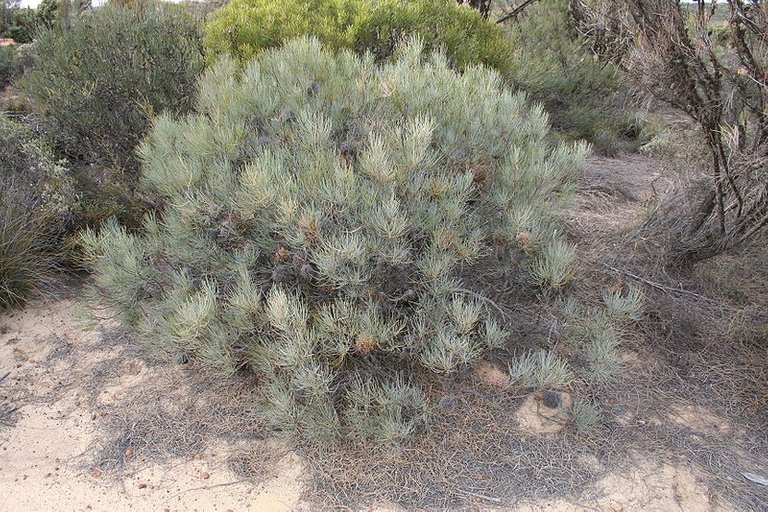The earliest known botanical collection of B. sphaerocarpa occurred in December 1801, during the visit of HMS Investigator to King George Sound. The specimen was collected from "A single plant observed between Princess Royal Harbour & Oyster Harbour on a heath",[6] and is credited to English botanist Robert Brown, though it is not possible to be certain on this point, as Brown incorporated the collections of junior expedition members into his herbarium without attribution. Neither Brown nor expedition horticulturist Peter Good mentions the collection in his diary.[7][8]
Brown published a formal description and name for the species in his 1810 On the Proteaceae of Jussieu.[9] He did not designate a type specimen (a specimen to be representative of the species) for the species, but the one specimen in his collection has since been formally declared the lectotype for the species.[10] He also did not state the etymology of the specific epithet, but it is accepted that the name derives from the Ancient Greek sphaera- ("round"), and carpos ("fruit"), in reference to the shape of its infructescences.[11]
In Brown's arrangement of the genus, B. sphaerocarpa was placed between B. pulchella and B. nutans in taxonomic sequence; that is, an order that places related taxa next to each other. No subdivision of the genus was given, other than to separate a single distinctive species into a subgenus of its own.[9] Swiss botanist Carl Meissner published a more detailed arrangement in 1856, placing B. sphaerocarpa in section Eubanksia because its inflorescence is a spike rather than a domed head, and in series Abietinae, whose members have inrolled leaf margins with no, or only very fine, serrations.[12] Meissner also published a variety, B. sphaerocarpa var. glabrescens, based on specimens collected by James Drummond; this is now considered a synonym of B. incana.[12]
George Bentham's revision of Banksia for his 1870 Flora Australiensis overturned Meissner's series; instead, B. sphaerocarpa was placed in a new section, Oncostylis, because of its hooked styles. Two varieties were recognised: Meissner's var. glabrescens was retained, and var. latifolia was newly described by Bentham. Bentham noted further variation amongst his specimens not accounted for by his varieties, stating "It is possible therefore that two species may be here confounded, but the specimens are insufficient for their distinction."[13]
For many years following Bentham's arrangement, the circumscription of B. sphaerocarpa was widely recognised as unacceptably broad. William Blackall informally published two varieties, var. pinifolia and var. violacea (properly Banksia violacea) in his 1954 How to Know Western Australian Wildflowers;[14] and in 1966 the nurseryman Fred Lullfitz predicted that there were as many as eight taxa within the species.[15] Several of these were recognised in George's revision of the genus for 1981 "The genus Banksia L.f. (Proteaceae)": B. micrantha, B. grossa, B. lanata, B. scabrella, B. telmatiaea, B. leptophylla[a] and B. incana.[10][16] George placed B. sphaerocarpa in subgenus Banksia because of its flower spike, section Oncostylis because its styles are hooked, and the resurrected series Abietinae, which he constrained to contain only round-fruited species. He reduced variety latifolia to synonymy with variety sphaerocarpa, but conceded the species needed further review.[10] Alex George reported that he thought Banksia sphaerocarpa's closest relatives to be Banksia micrantha and B. grossa.[2]
George's arrangement remained current until 1996, when Kevin Thiele and Pauline Ladiges published an arrangement informed by a cladistic analysis of morphological characteristics. They retained George's subgenera and many of his series, but discarded his sections. Banksia ser. Abietinae was found to be very nearly monophyletic, and so retained. It further resolved into four subclades, so Thiele and Ladiges split it into four subseries. Banksia sphaerocarpa appeared in the second of these, initially called the ' grossa clade' for its most basal member. As with George's classification, B. grossa and B. micrantha emerged as close relatives of B. sphaerocarpa.
B. grossa
B. dolichostyla
B. micrantha
B. sphaerocarpa var. sphaerocarpa
B. sphaerocarpa var. caesia
This clade became the basis for new subseries Sphaerocarpae, which Thiele defined as containing those species with lignotubers, styles loosely curling around the infructescence (although this trait was reversed in micrantha), and "transversely aligned cells of the seed wing inner face". Other than the most basal B. grossa, these species also have shouldered follicles. Having found B. micrantha to be more closely related than B. sphaerocarpa var. dolichostyla to the other varieties of B. sphaerocarpa, they promoted var. dolichostyla to species rank as Banksia dolichostyla. Morphological support for this was given by the fact that the old styles of var. dolichostyla are quite different from those of other varieties, being stouter, and tending not to curl around the infructescence as the others do.[17]
Questioning the emphasis on cladistics in Thiele and Ladiges' arrangement, George published a slightly modified version of his 1981 arrangement in his 1999 treatment of Banksia for the Flora of Australia series of monographs. He added that he did not feel the characters of dolichostyla alone justified specific rank, being essentially merely larger in all parts than, but otherwise essentially similar to, var. caesia. Therefore, he retained it as a variety of B. sphaerocarpa. To date, George's 1999 arrangement remains the most recent comprehensive classification. The placement of B. sphaerocarpa in George's 1999 arrangement may be summarised as follows:[2]

Hi! I am a robot. I just upvoted you! I found similar content that readers might be interested in:
https://www.scribd.com/document/375421212/Banksia-Sphaerocarpa